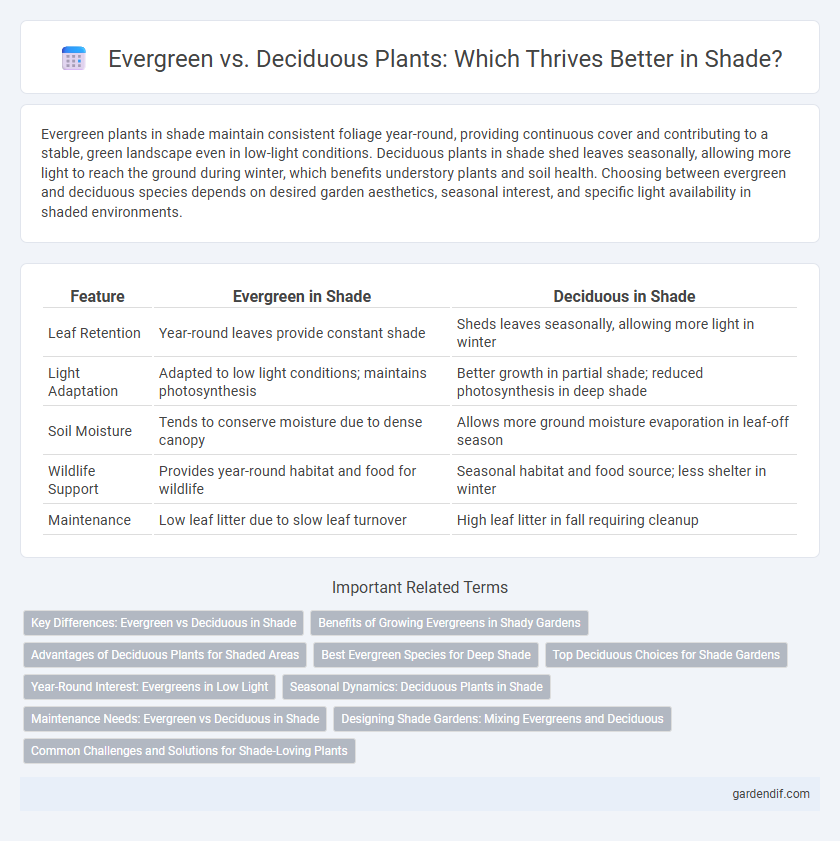
Evergreen in Shade vs Deciduous in Shade Illustration
Evergreen plants in shade maintain consistent foliage year-round, providing continuous cover and contributing to a stable, green landscape even in low-light conditions. Deciduous plants in shade shed leaves seasonally, allowing more light to reach the ground during winter, which benefits understory plants and soil health. Choosing between evergreen and deciduous species depends on desired garden aesthetics, seasonal interest, and specific light availability in shaded environments.
Table of Comparison
| Feature | Evergreen in Shade | Deciduous in Shade |
|---|---|---|
| Leaf Retention | Year-round leaves provide constant shade | Sheds leaves seasonally, allowing more light in winter |
| Light Adaptation | Adapted to low light conditions; maintains photosynthesis | Better growth in partial shade; reduced photosynthesis in deep shade |
| Soil Moisture | Tends to conserve moisture due to dense canopy | Allows more ground moisture evaporation in leaf-off season |
| Wildlife Support | Provides year-round habitat and food for wildlife | Seasonal habitat and food source; less shelter in winter |
| Maintenance | Low leaf litter due to slow leaf turnover | High leaf litter in fall requiring cleanup |
Key Differences: Evergreen vs Deciduous in Shade
Evergreen plants in shade maintain their foliage year-round, allowing continuous photosynthesis and providing consistent cover, while deciduous plants shed leaves seasonally, reducing light interception during dormant periods. Evergreen species often exhibit slower growth rates but higher shade tolerance, whereas deciduous species tend to have faster growth in shaded conditions but depend on seasonal leaf cycles for energy conservation. The structural and physiological adaptations distinguish evergreens' persistent shade advantage from the seasonal light-dependent strategies of deciduous plants.
Benefits of Growing Evergreens in Shady Gardens
Evergreens thrive in shady gardens by providing year-round foliage, enhancing landscape aesthetics even in low-light conditions. Their ability to maintain dense, green coverage supports consistent habitat for wildlife and contributes to improved air quality. Evergreen plants also offer structural interest and privacy, making them ideal choices for shaded garden areas where deciduous plants may struggle to flourish.
Advantages of Deciduous Plants for Shaded Areas
Deciduous plants in shaded areas offer distinct advantages by allowing seasonal variation in light availability; their leaf drop in winter permits increased sunlight penetration, benefiting understory vegetation and improving soil nutrient cycling. These plants adapt to shade through large, thin leaves that maximize photosynthesis during growing seasons, supporting biodiversity and ecosystem balance. Deciduous species also enhance microclimates by moderating temperature and moisture levels, fostering healthier shaded environments compared to evergreens.
Best Evergreen Species for Deep Shade
In deep shade environments, selecting the best evergreen species is crucial for year-round greenery and low maintenance. Boxwood (Buxus sempervirens) and Japanese holly (Ilex crenata) thrive in low-light conditions, offering dense foliage and excellent shade tolerance. Other top choices include Oregon grape (Mahonia aquifolium) and yew (Taxus baccata), both known for their adaptability to deep shade and evergreen characteristics.
Top Deciduous Choices for Shade Gardens
Top deciduous trees for shade gardens include the Japanese Maple (Acer palmatum), which thrives in partial shade and offers vibrant fall color. The Serviceberry (Amelanchier spp.) provides multi-season interest with spring flowers and edible berries while tolerating shade conditions. Dogwood (Cornus florida) is another excellent choice, adapting well to shaded environments and adding ornamental value with its distinctive blooms.
Year-Round Interest: Evergreens in Low Light
Evergreen plants in shade provide consistent year-round interest with their persistent green foliage, unlike deciduous plants that lose leaves and visual appeal in low light during autumn and winter. Their ability to photosynthesize efficiently in shaded environments makes evergreens ideal for maintaining vibrant garden aesthetics throughout all seasons. Shade-tolerant evergreens such as boxwood, holly, and yew are popular for adding structure and color even in areas with minimal sunlight.
Seasonal Dynamics: Deciduous Plants in Shade
Deciduous plants in shade exhibit distinct seasonal dynamics, characterized by leaf senescence and abscission in autumn, which allows increased light penetration to understory vegetation during winter. These seasonal leaf drops contribute to nutrient cycling and soil enrichment, supporting evergreen species and other shade-adapted flora. The phenological timing of leaf emergence and loss in deciduous shade plants significantly influences microclimate regulation and understory biodiversity throughout the year.
Maintenance Needs: Evergreen vs Deciduous in Shade
Evergreen plants in shade generally require less maintenance due to their year-round foliage, which reduces the need for seasonal cleanup and pruning compared to deciduous plants. Deciduous plants in shade demand more frequent maintenance, especially in autumn when they shed leaves, necessitating regular raking and removal to prevent mold and pests. Both types benefit from consistent watering and soil care, but evergreens typically need less seasonal attention to keep their appearance in shaded environments.
Designing Shade Gardens: Mixing Evergreens and Deciduous
Mixing evergreens and deciduous plants in shade gardens creates year-round visual interest and structural diversity, with evergreens providing consistent foliage and deciduous plants offering seasonal variation through leaf color and texture changes. Selecting shade-tolerant species like boxwood and holly for evergreens, and hostas or dogwoods for deciduous, ensures a harmonious balance of form and function. Strategic layering of these plants enhances microclimates, supports biodiversity, and maximizes garden aesthetics in low-light environments.
Common Challenges and Solutions for Shade-Loving Plants
Evergreen plants in shade often face challenges such as reduced photosynthesis due to limited light, leading to slower growth and increased susceptibility to pests and diseases. Deciduous shade plants commonly struggle with competition for nutrients and moisture, especially during dry periods or in dense shade where leaf litter inhibits soil aeration. Solutions include selecting shade-tolerant species with efficient low-light adaptations, applying organic mulch to conserve moisture, and ensuring proper soil drainage and occasional fertilization to support healthy root systems.
Evergreen in Shade vs Deciduous in Shade Infographic

 gardendif.com
gardendif.com